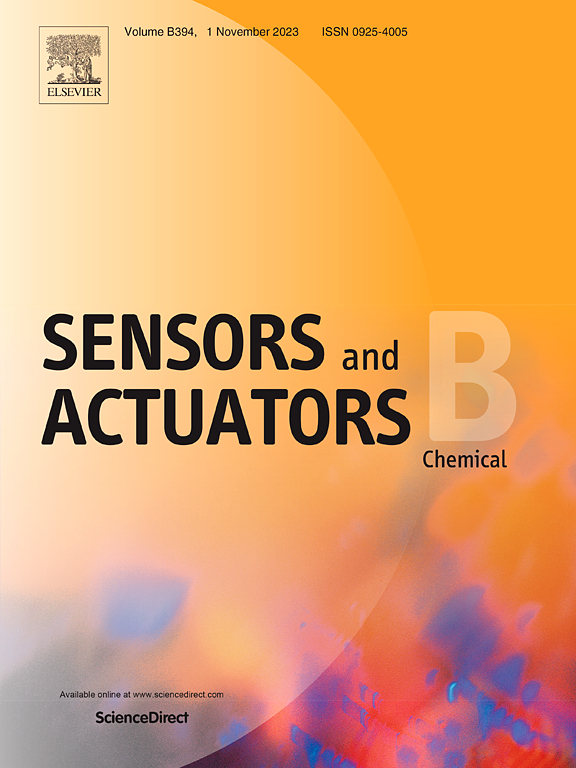A MXene-Au nanosheets-based fluorescent-SERS dual-mode biosensor integrated with CRISPR/Cas12a system for endotoxin detection
IF 8
1区 化学
Q1 CHEMISTRY, ANALYTICAL
引用次数: 0
Abstract
Endotoxins or lipopolysaccharides (LPS) are potent inflammatory agents that pose serious health risks even at low concentrations, thus requiring sensitive and reliable detection methods. Current methods for endotoxin detection, primarily the Limulus Amebocyte Lysate (LAL) assay and Enzyme-linked Immunosorbent Assays (ELISA) are limited by complex procedures, prolonged assay time, and susceptibility to interference. To address these challenges, we developed a single-reporter probe-based dual-mode biosensor integrating MXene-Au nanosheets with the CRISPR/Cas12a system for endotoxin detection. The sensing platform was constructed by conjugating ssDNA-Cy5 reporters onto MXene-Au nanosheets. MXene-Au nanosheets served dual functions, including efficient quenching of fluorescence and strong enhancement of SERS signals. In the presence of target endotoxins, CRISPR/Cas12a remains inactive, leaving the ssDNA-Cy5 reporters intact on the MXene-Au surface. The close proximity of Cy5 to the MXene-Au surface results in quenched fluorescence (“FL off”) but enhanced SERS signals (“SERS on”). Conversely, in the absence of endotoxins, activated CRISPR/Cas12a cleaves the ssDNA-Cy5, releasing Cy5 from the surface, thus leading to fluorescence recovery (“FL on”) but diminished SERS signals (“SERS off”). By measuring the changes in SERS and FL signals and analysing the ratiometric ISERS/IFL signals, the biosensor achieved a lower limit of detection (LOD) of 15.9 pg/mL within 30 minutes compared to single detection modes. Validation studies in complex matrices, including spiked water and milk samples, showed performance comparable to commercial endotoxin detection kits. Overall, our CRISPR-Cas12a-mediated fluorescent-SERS dual-mode biosensor not only improves detection sensitivity but also provides built-in quality control, improving the reliability of results through cross-validation.
集成CRISPR/Cas12a系统的MXene-Au纳米片荧光- sers双模生物传感器用于内毒素检测
内毒素或脂多糖(LPS)是强效炎症因子,即使在低浓度下也会造成严重的健康风险,因此需要敏感可靠的检测方法。目前的内毒素检测方法,主要是鲎试剂(LAL)测定法和酶联免疫吸附测定法(ELISA),由于程序复杂、测定时间长、易受干扰而受到限制。为了解决这些挑战,我们开发了一种基于单报告探针的双模式生物传感器,将MXene-Au纳米片与CRISPR/Cas12a系统集成在一起,用于内毒素检测。通过将ssDNA-Cy5报告子偶联到MXene-Au纳米片上构建传感平台。MXene-Au纳米片具有有效猝灭荧光和增强SERS信号的双重功能。在目标内毒素存在的情况下,CRISPR/Cas12a保持无活性,使ssDNA-Cy5报告基因完好无损地留在MXene-Au表面。Cy5靠近MXene-Au表面导致荧光猝灭(“FL关闭”),但SERS信号增强(“SERS打开”)。相反,在没有内毒素的情况下,激活的CRISPR/Cas12a切割ssDNA-Cy5,从表面释放Cy5,从而导致荧光恢复(“FL on”),但SERS信号减弱(“SERS off”)。通过测量SERS和FL信号的变化,并分析比率计的ISERS/IFL信号,与单一检测模式相比,该生物传感器在30分钟内的下限检测(LOD)为15.9 pg/mL。在复杂基质中进行的验证研究,包括加标水和牛奶样品,显示出与商业内毒素检测试剂盒相当的性能。总的来说,我们的crispr - cas12a介导的荧光- sers双模生物传感器不仅提高了检测灵敏度,而且提供了内置的质量控制,通过交叉验证提高了结果的可靠性。
本文章由计算机程序翻译,如有差异,请以英文原文为准。
求助全文
约1分钟内获得全文
求助全文
来源期刊

Sensors and Actuators B: Chemical
工程技术-电化学
CiteScore
14.60
自引率
11.90%
发文量
1776
审稿时长
3.2 months
期刊介绍:
Sensors & Actuators, B: Chemical is an international journal focused on the research and development of chemical transducers. It covers chemical sensors and biosensors, chemical actuators, and analytical microsystems. The journal is interdisciplinary, aiming to publish original works showcasing substantial advancements beyond the current state of the art in these fields, with practical applicability to solving meaningful analytical problems. Review articles are accepted by invitation from an Editor of the journal.
文献相关原料
公司名称
产品信息
阿拉丁
chloroauric acid trihydrate (HAuCl4·3 H2O)
阿拉丁
Carboxymethyl cellulose sodium (CMC, 800 ?1200 mPa·s)
阿拉丁
endotoxin from Escherichia coli (O55:B5) (L4524)
阿拉丁
chloroauric acid trihydrate
阿拉丁
Carboxymethyl cellulose sodium
阿拉丁
endotoxin
 求助内容:
求助内容: 应助结果提醒方式:
应助结果提醒方式:


